The Type 82 destroyer only had a single ship in class built for the Royal Navy, HMS Bristol (D23). She was intended as the first of new large destroyers escorting the CVA-01 aircraft carriers planned for the early 1970s. But the the 1966 Defence White Paper had both cancelled as budget cuuts measures. She had a long career including the Falklands War, and further after being converted as a training ship in 1987. But by 1991 she had a boiler explosion as part of the Dartmouth training squadron and was never repair, nor sold to another navy, and became the Harbour Training ship HMS Excellent until decommissioned in Portsmouth on 28 October 2020. #coldwar #royalnavy #britishnavy #falklandswar #bristol #destroyer #guidemissiledestroyer #type82destroyers
Development of the Type 82 guided missile destoyers
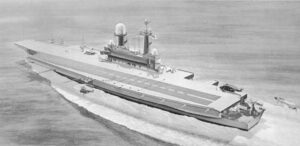 The new carriers planned for the 1970s such as the later cancelled CVA-01 would need escorts to provide them with anti-aircraft and anti-submarine defence and so four new DLGS were planned to follow the “County’ class. Although rated as DLGS, for some reason they were given Type No 82 in the general-purpose frigate series (originally known as CF299 frigates). With the cancellation of CVA-01 in 1966 it would have been logical to cancel them as well, and indeed the Board of Admiralty was willing to accept seven extra Leander class frigates in their place, but a trials ship had been promised for Netherlands ‘Broomstick’ radar project in the hope that the Netherlands would order the Olympus gas turbine.
The new carriers planned for the 1970s such as the later cancelled CVA-01 would need escorts to provide them with anti-aircraft and anti-submarine defence and so four new DLGS were planned to follow the “County’ class. Although rated as DLGS, for some reason they were given Type No 82 in the general-purpose frigate series (originally known as CF299 frigates). With the cancellation of CVA-01 in 1966 it would have been logical to cancel them as well, and indeed the Board of Admiralty was willing to accept seven extra Leander class frigates in their place, but a trials ship had been promised for Netherlands ‘Broomstick’ radar project in the hope that the Netherlands would order the Olympus gas turbine.
Fallen under the 1966 white defence paper axe
Finally, the class was cut back to one unit, the reason being that she could act as a trials ship for new the British made weapons. Although superficially resembling “cleaned-up’ “County’ class, the design incorporated another generation of equipment and ideas. The Sea Dart missile version of the system used vertical stowage and a twin-arm zero-length launcher like USN systems, and is a semi-active homing missile with a much greater capacity to handle multiple targets.
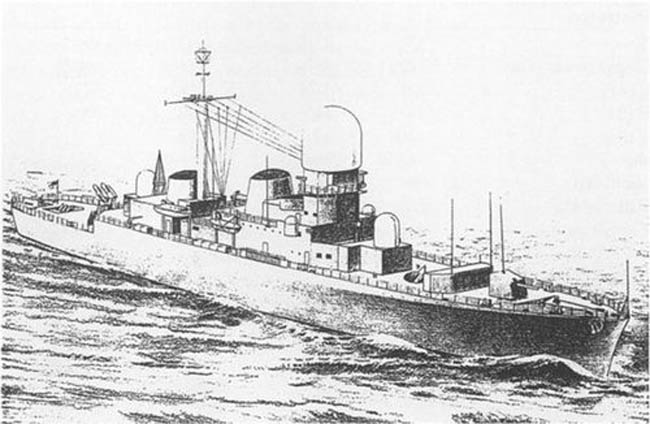
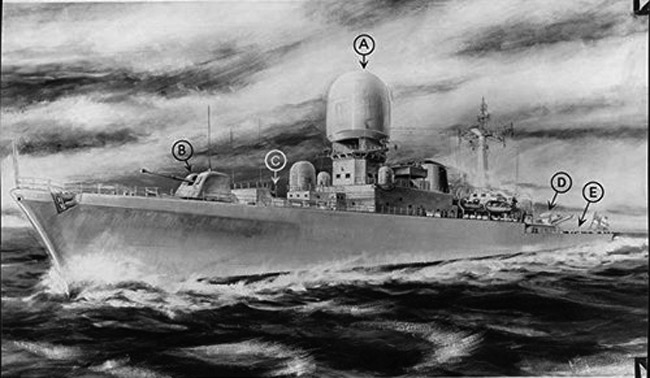
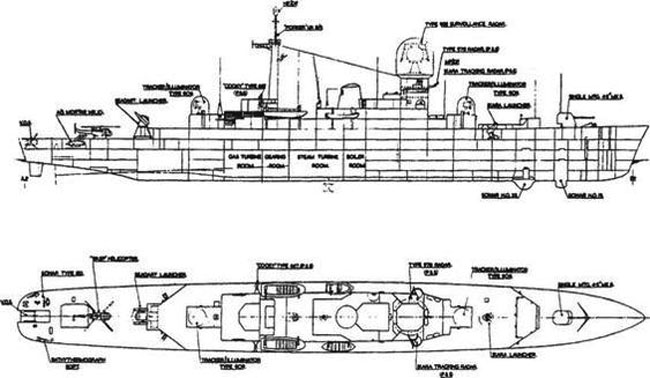
Evolution of the Type 82 (secretproject.org)
Although the same type of COSAG machinery was adopted, much more attention was paid to providing good access to the gas turbines. The result was that the design changed from a single-funnel to a two-funnel configuration and finally to three funnels, the after uptakes being split into two separate funnels to allow access to the Olympus gas turbines. Bristol was thus the first RN ship to be designed around the new concept of upkeep by replacement, which reduces the time spent on machinery overhauls. Although nearly 1000t bigger than the ‘Counties’, she needed seventy men fewer to run her. She was also the first RN ship to go sea with the Anglo-Australian Ikara ASW missile system, mounted in a ‘zareba’ forward of the bridge.
Order and construction
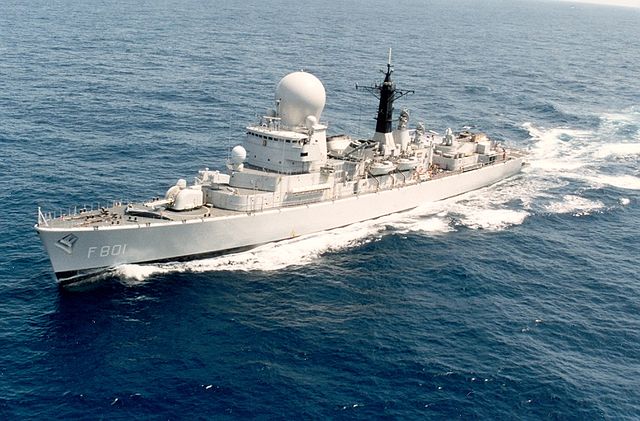
F801 Tromp, a Dutch “variant” or what could have been the Type 82
The CVA-01 fleet aircraft class was supposed to replace all WW2 legacy aircraft carriers of the Royal Navy and to escort these oceanic, large carriers only comparable to US supercarriers at the time, four new Type 82 area air defence destroyers were planned as escorts. In 1963, MoD Peter Thorneycroft announced in Parliament a budget of £56 million for the carriers but the new government and strong lobbying from the RAF intended to use the later cancelled Hawker P.1154 supersonic V/STOL had them curttailed after the 1966 Defence White Paper, eliminated the Type 82 class altogether, and the RN save it from scrapping by replanning it on 4 October 1966 as testbed for new missile and radar technologies.
HMS Bristol thus, having being laid down at Swan Hunter, Tyne and Wear Naval Yard on 15 November 1967, was launched on 30 June 1969 and eventually Commissioned on 31 March 1973, to test four new weapons and electronics systems. A construction time of seven years was quite long for a destroyer, but she was grounbreaking, far more than the County class and at a much higher cost of £24,217,000 as estimated. She played a major part in the development of future, much smaller and cheaper classes of missile destroyers for the Royal Navy, but also as training ship.
Design of the class
Hull and general design
Externally, her hull was not that different from the County class destroyers. She measured 155 m (507 ft) but with 17 m (55 ft) in beam and 7.5 m (24 ft 7 in) in draught, so actually shorter but wider, deeper than the Counties (158.54 x 16 x 6.4 m/520.16 x 54 x 21 ft) and was a bit heavier at 6,400 tonnes (standard), 7,100 tonnes fully loaded for Displacement versus 6,200t; 6,900 t FL for the Counties.
Like the Counties, she had a long, clean hull albeit with a unusual top knuckle, broken 20% from the stern, creating a long forecastle. She also hared two funnels but the superstructure was more jagged, pushed back and awkward than the Counties, mostly due to the decision of placing the forward main radome in front of the bridge rather than above or beyond. Paraxoically, the forward single main gun was located close to the bow, followed by a vertical missile launcher, then the radome, and a rather tall command bridge, short formast, funnel, utility structures and boats under davits, light close-in defense weaponry, then the aft, much taller composed mast (combo of radars) and aft funnel, then aft SAM guiding radome, and aft twin SAM launcher at deck level close to the stern, then ASW gear.
Powerplant
Although the same type of COSAG machinery was adopted, much more attention was paid to providing good access to the gas turbines. The result was that the design changed from a single-funnel to a two-funnel configuration and finally to three funnels, the after uptakes being split into two separate funnels to allow access to the Olympus gas turbines. Bristol was thus the first RN ship to be designed around the new concept of upkeep by replacement, which reduces the time spent on machinery overhauls. Although nearly 1000t bigger than the ‘Counties’, she needed seventy men fewer to run her.
The County class pioneered composite gas turbines powerplants, having COSAG with two B&W boilers, two GS turbines for 30,000 shp, 30 knots and a Range of 3,500 nautical miles at 10 knots and the same system was repeated on HMS Bristol, with two standard range geared steam turbines for the same output of 30,000 hp (22,000 kW) and two Bristol-Siddeley Olympus TM1A gas turbines also delivering 30,000 hp, plus two boilers on two shafts, for a top speed of 28 knots (52 km/h) compensated bt a greater range of 5,750 nautical miles (10,650 km) at 18 knots (33 km/h), as they were intended to follow the CVA01 on seven seas. They would have very “long legs” the greatest of any British destroyers. This came in handy later in her career when undergoing long training cruisers overseas.
Armament
Bristol saw a number of new systems introduced into the Navy, including the Sea Dart anti-aircraft and Ikara anti-submarine missile systems and was the first Royal Navy ship to carry the 4.5 inch (113 mm) Mk 8 gun. Another addition to the fleet was the new advanced Action Data Automated Weapons System Mk.2 (ADAWS-2), a computer system designed to coordinate the ship’s weapons and sensors. ADAWS-2 was a large advance on the rudimentary action information system of its predecessor the County-class destroyers, which was heavily reliant on manual data input.
Main: Sea Dart SAM
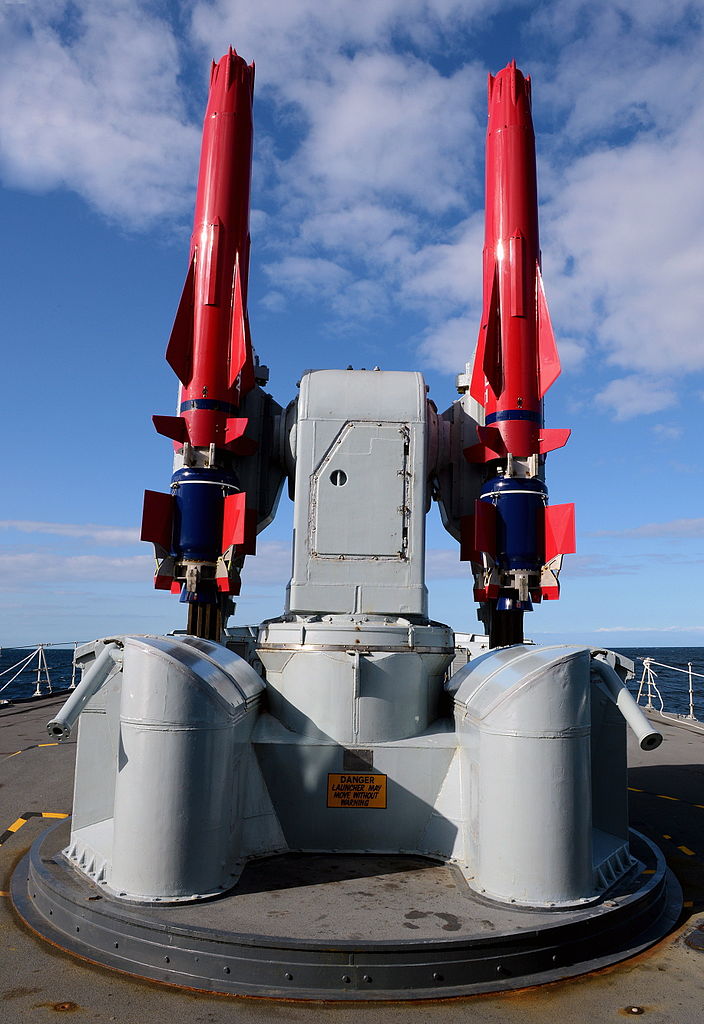
The Sea Dart (GWS 30) system comprised a twin-arm launcher on the quarterdeck with a pair of radar Type 909 target illumination sets, an improvement over the single radar Type 901 set of the County design. This was the brand new novelty in the design, completely surclassing the bulky and large Seaslug GWS SAM. This was a brand new generation SAM, and a successful one, albeit very costly.
Early experiments of the 1950s lead to the development of the Seaslug syste had limitations against faster aircraft or anti-ship missiles, was too large to be carried in a frigate, leading to considerations on a new high-performance DACR (direct-action, close-range) gun, but still an interceptor for future anti-ship missiles was needed, leading in October 1960, to launch the Small Ship Integrated Guided Weapon project to fill this niche. SIGS called for a small weapon to b installed on a 3,000 ton frigate and able to shot down high altitude jet bombers still, as well as the latest anti-shipping missiles or to be used as SSM againts frigate size ships. It turned out overambitious and very costly, later leading to see an entirely new class of weapon. She narrowly escape the axe. The only reason why she was not chosen over the NATO US RIM-24 Tartar was that her development wa co-financed later by the interested Netherlands. In the end, the Sea Dart entered service in 1970 and was produced to 2000+ until retirement in 2020.

⚙ Sea Dart specifications |
|
| Weight | 550 kg (1,210 lb) |
| Dimensions | 4.4 x 0.42, wp 0.9m (14 ft x 17 in x 3.0 ft) |
| Warhead | 11 kg (24 lb) HE blast-fragmentation, Proximity fuze and contact |
| Engine | Chow solid-fuel booster motor + Bristol Siddeley Odin ramjet cruise motor |
| Range, mod 0 | 40 nmi (46 mi; 74 km) |
| Flight ceiling | 18,300 m (60,000 ft) |
| Maximum speed | Mach 3.0+ |
| Guidance | Semi-active radar illuminated by radar Type 909 (J-band) |
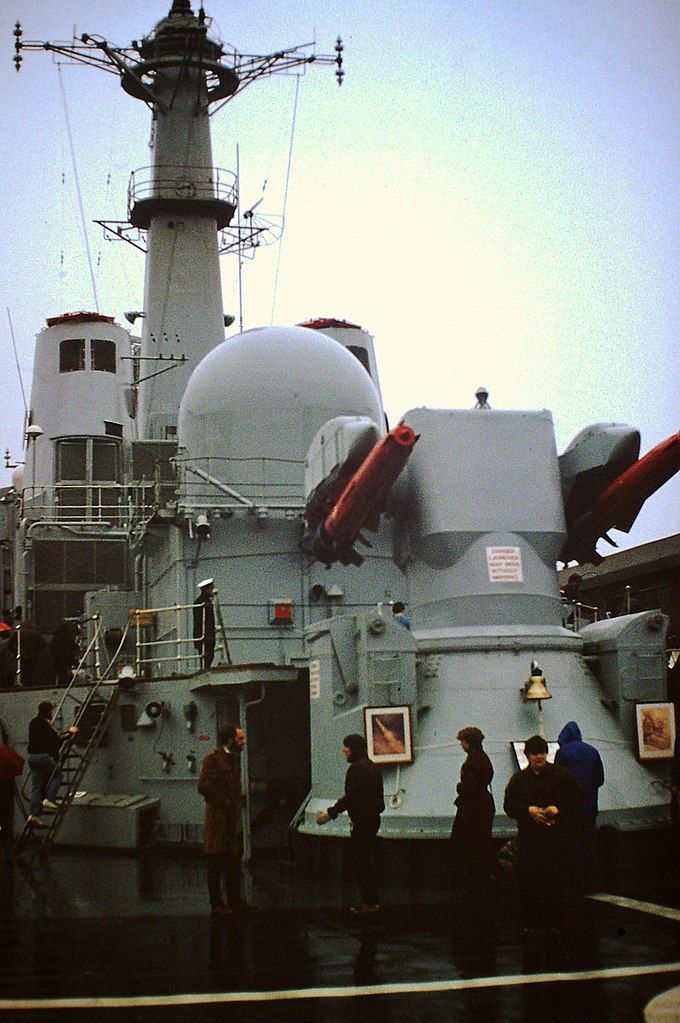
Ikara ASWMs
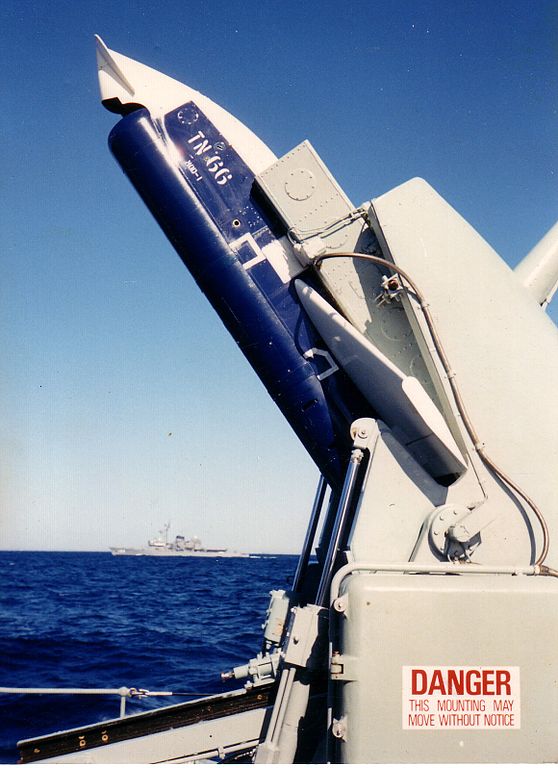
The second weapon system was the Australian Ikara anti-submarine weapon. Ikara was a rocket-powered carrier that could deliver a small homing torpedo out to 10 miles (16 km) from the ship. The Ikara was a commonwalth equivalent to the USN ASROC system, with the same idea, essentually projeting on a submarine a homing torpedo from a missile carrier, at a range exceeding the capacity of standard torpedoes. Still, it was relatively short range, especially compared to the Soviet Navy own systems in the 1970s, but compared well to the ASROC.
The Ikara was an Australian ship-launched anti-submarine missile (“throwing stick”) delivering an acoustic to 10 nautical miles (19 km). It was so successful as being adopted from 1960 by the RAN, NR, RNZN, Brazilian and Chilean Navy and only retired in the 1990s.
The missile weighted 513 kilograms (1,131 lb) for 3.429 metres (135.0 in) long and a Wingspan of 1.524 metres (60.0 in) carrying a Warhead Mark 44, Mark 46 torpedo of for the RN, NDB (Nuclear Depth Bomb).
It was powered by a Bristol Aerojet Murawa two-stage solid-fuel rocket engine at 713 kph (443 mph) and 335 metres (1,099 ft) alt. cruising at 658 kph (409 mph) to target by Command guidance. Unlike the French Malafon system, it had its acoustic torpedo semi-recessed in the fuselage for better aerodynamic profile. The acoustic seeker of the Mk.44 torpedo was limited to 457 metres (1,499 ft) at first but it was constantly improved.
Mark 10 Limbo ASWMo.
Ikara was complemented by the Mark 10 Limbo Anti-submarine Mortar, the sold proven system aboard. The 1955 triple ASW mortar system throwed a 400 lb 12-inches (305 mm) depth charge at 400 yards (366 m) to 1,000 yards (914 m). The Warhead contained 94kgs of Minol, using Proximity and/or time Guidance. The weapon system received data by the Type 170 sonar.
single 4.5 inch (113 mm) Mark 8
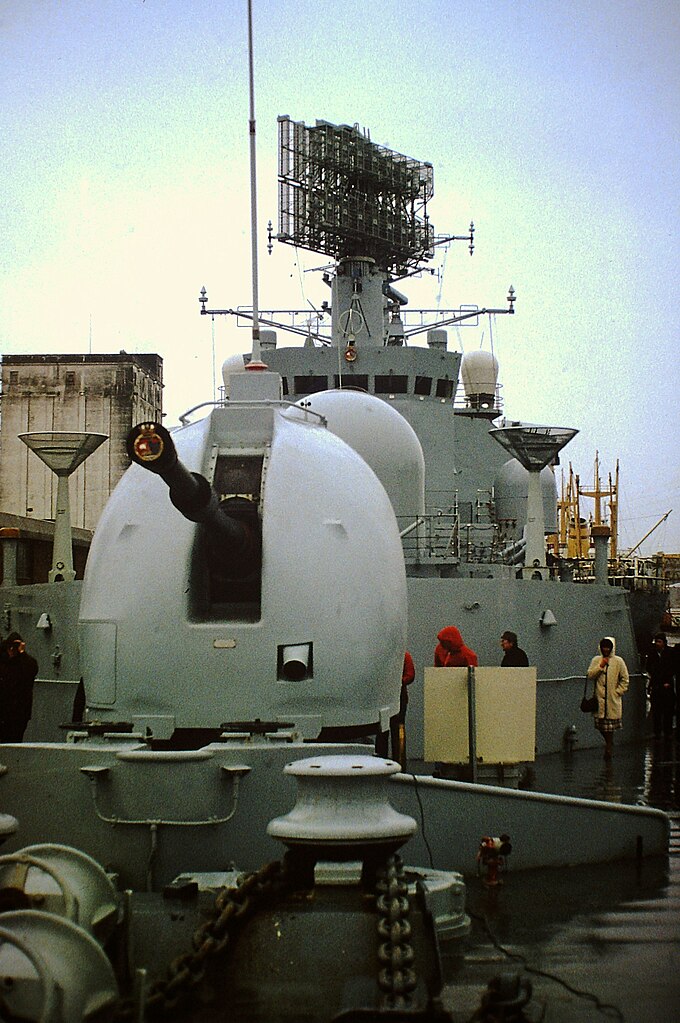
The new 4.5in Mk 8 gun in a Vickers mounting replaced the old Mk 6 twin, but only one was provided, in ‘A’ position. It was not intended as an anti-aircraft weapon, and as such had an elevation of only 55°. The weapon was designed specifically for reliability over rate of fire, allowing only a single mounting to be shipped, and the comparatively low rate of fire of 25 rounds per minute was ample for the intended anti-ship and shore-bombardment roles.
Sensors
Work had been proceeding on a joint Anglo-Netherlands project to produce a Comprehensive Display System (CDS) radar for air warning, surveillance and aircraft direction, and it was to be mounted over the bridge, but the rising cost of research and development, combined with the belief that there would be no need for such a system because there would be no carrier-aircraft to direct, led to Britain withdrawing from the scheme.
The original design planned a 3-D air search radar, the joint Anglo-Dutch Type 988 “Broomstick” fitted on the bridge as on the CVA-01 design. But cost concerned had it shit down for the older Type 965 air search radar and “twin bedstead” AKE-2 antennae mounted on the stump foremast. The Type 992Q low-angle search radar was planed on the mainmast. This combo was not much advanced than on the County class. Type 909 sets were installed also fore and aft to control each of the Sea Dart missiles control.
It’s really in sensor data processing/display that HMS Bristol shone. This ADAWS-2 system was based on a suite of Ferranti FM1600 computers, providing a solid base for identification, tracking and targets engagement. ADAWS-2 accepted a wide range of data and provided a track histor for many simultaneous “bogeys” evaluating threat levels, controlling engagement with the corresponding weapons systems in an automatic fashion with light oversight/command for a few operators from a safe operations room.
The whole electronics site comprises the following:
-ADAWS-2 combat direction system
-One Type 965 2D air warning radar (later Type 1022 2D air search)
-One Type 992Q low-angle target indication
-Two Type 909 Sea Dart target illumination radars
-One Type 978 (later 1006) navigation radar
-One Type 170 search sonar (providing data to the Ikara)
-One Type 184 target indication sonar (same).
At the same data from the radar and sonar plots, the inertial navigation system, and any other source, and processed it via a suite of digital computers.
Other perks
Since air cover was supposed to be covered by the CVA01 carriers, the Type 82 missile destroyers were not provided with an helipad, hangar or any helicopter. She however later had a flight deck added when the Limbo ASW mortar was removed and plated over so to be able to support heavy lift helicopters, like the Chinook. Bristol, although capable of landing a Westland Wasp helicopter on the quarterdeck, lacked a hangar and aviation facilities and thus had to rely on external air support.
HMS Bristol was to be next-gen compared to the Counties, and was highly automated. This reduced the crew acordingly to 397 (30 officers) compared to 471 (33 officers, 438 ratings), quite a substantial difference. As a result, she felt roomier, even comfy, and was appreciated by the crews.


Conway’s profiles: County above, Bristol below to compare.
⚙ specifications |
|
| Displacement | 6700/7700 tonnes FL |
| Dimensions | 149.3/154.3 x 16.8 x 6.8 m (507 x 55 x 24 ft 7 in) |
| Propulsion | 2 shaft COSAG: 2 GS Turbines, B&w boilers, Olyumpus TMIA Gas Turbines 30,000+44,000 hp |
| Speed | 28 knots (52 km/h) |
| Range | 5,750 nautical miles (10,650 km)/18 kts |
| Armament | 1x 4.5 in/55 Mk8, Twin Sea Dart GWS30 SAM (32), Ikara (32), Limbo Mk10 |
| Sensors | Radar 902, 978, 1006, 92/993, Sonar 184, 162 |
| Crew | 397 (30 officers) |
Impact of the class
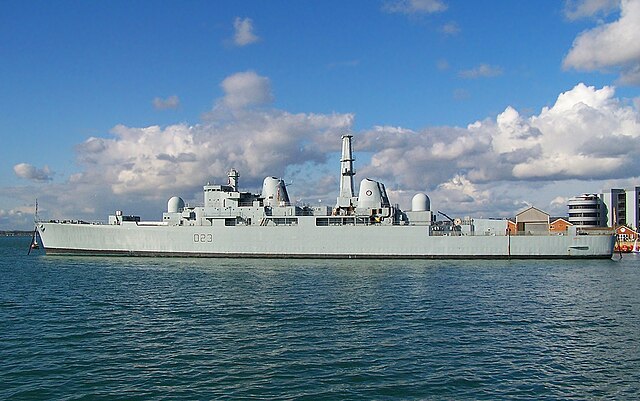
Bristol in Portsmouth, 2008
The Type 82 was loosely based on the County-class and Type 12I Leander-class frigates (she was numbered as an escort Type) but she improved weapon and command across the board, and provided a true replacement for WW2 legacy cruisers, the last (apart the Tiger class) being decommissioned in 1962-65.
The County class for example depended on the external data links from aircraft carriers (Eagle, Hermes, Victorious) with their powerful 984 3D radar/ADWAS computers tracking up to 50-100 targets and combining responses. The Tiger-class were not good CiC escort between their unreliable machinery and often jamming artillery. She showed their limits off Suez whereas the Battle-class and Daring-class destroyers appeared too small for an efficient escort. The Counties had now near obsolete 4.5-inch and Seaslug missiles with unsufficient helicopter facilities. The war between Malaya and Indonesia in 1963-1996, showed the growing threat of cruise-missile armed jet bombers. For them, the RN carriers with their subsonic de Havilland Sea Vixen/Supermarine Scimitar were sitting ducks, in addition of their small air group of 25 aircraft. All pointed to the construction of the new generation of “supercarrier” (to British standards) and thus, to create a relevant escort with missile capabilities equal to the USN Talos/Terrier systems.
The admiralty had a new ASW requirement for converted helicopter cruisers or carriers and pressed the dual conventional/nuclear missile/anti-submarine missiles to the newly developed Type 82 from 7 July 1965.
The Type 82 were to be more spacious, leaving room for upgrades (as a “what if add-on armour” ideal for the 1982 Falklands conflict), better crew functionality, more automation, and in particular, range. This all made, inclduing the new weapons system and a very ambitious (but later proved too costly) electronics suite. The Type 82 were seen as a game changer, alt least until the 1966 “white paper”.
Although fitted with a modern combined steam and gas (COSAG) she became the last warship of Royal Navy still powered by steam and the exhaust system differed from the County class by its unique three-funnelled layout, although two were in tandem. HMS Bristol escame the axe, rebranded as a testbed of new weapons system, while the electronics were toned down, apart the game-changing command and control technologies making her a breakthough ship for the RN. Even though the rest of the class was cancelled, she would provided an ideal testbed for future destroyer designs.
However despite of this, her full potential was never realized. Sure, she introduced many new systems, but her role never materialised due to the cancellation of the CV01, and later of the WW2-legacy carriers. In 1973 she was found without operational role or requirement to fill, with changing priorities. A large ship, despite automation, she remained manpower and maintenance intensive and thus, costly to operate, not to the new standard required, showed by the next generation of destroyers, much smaller. The 1975 Type 42 or Sheffield class for example were much smaller, 3,500/4,100 long tons for the first batch, compared to 7,000+ tons, and with a crew of cut almost by half, albeit in cramped spaces.
Her major shortcomings were the lack of a propoer air component and long-range anti-ship missile. Meaning that in a carrier battle group other ships had to provide this capability. She became limited to squadron duties and was seen as a “white elephant” by many in the 1970-80s sucessive governments, escaping forced decommission several times.
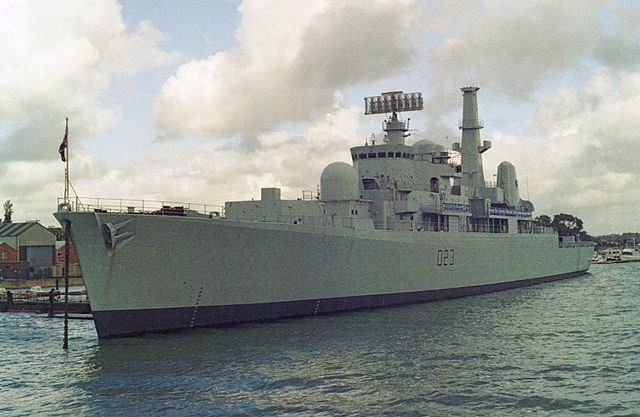
Career of HMS Bristol (1973-2020)
She spent her early service spent trialling her new systems, building experience but suffered in 1974 a serious, almost fatal, damage when her steam plant, which was virtually destroyed by fire. For a time it was feared that she would be scrapped, but she was able to complete the Ikara and Sea Dart trials programme running only on the two gas turbines. This helped to convince doubters about the wisdom of time, the Netherlands was disenchanted with the spiralling cost (and volume) of the Sea Dart missile system; by mutual consent the CDS was dropped, and Bristol went to sea with the less capable Type 965 (AKE-2).
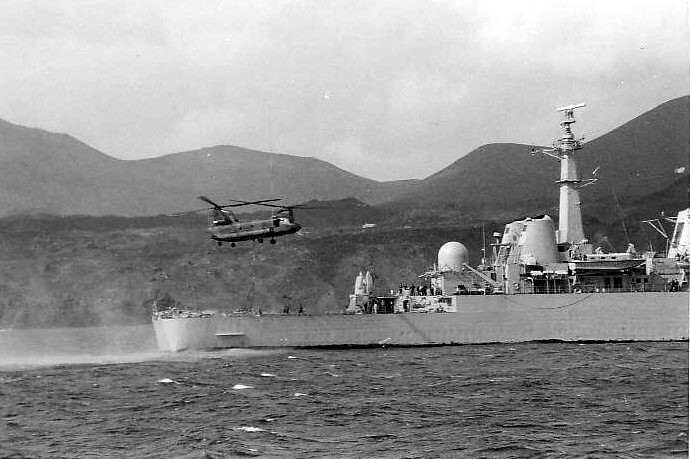
Bristol off the Ascension island, showing her helipad hovered by a CH-47 Chinook of the Royal Marines, Falklands, 1982
Thanks to her size she was used as flagship, accomodating well extra staff. She became in effect Royal Navy flagship for NATO Exercise Ocean Safari 81. The steam plant was repaired in 1976 and by 1979 she was fitted out for frontline service at least, gaining a an ECM, the Corvus countermeasures launchers plus two WW2 stock Oerlikon 20 mm cannons for asymetric close-in engagements. The same refit saw the Limbo removed and its well became a… makeshift swimming pool. This short refit saw the former Limbo well plated over to allow large helicopter landings on her quarterdeck at last. Her intended big half-life modernisation of 1981 was rescinded but a Type 1022 radar replaced the Type 965 and she had scores of other improvements made. In effect she later joined the task force in the South Atlantic and took part in the 1982 Falklands War as component of the carrier battle-group based around HMS Hermes at last. After the war she remained flagship.

Despite as being as being ‘white elephant’ she was more popular than the cramped Type 42 destroyers and proved a surprisingly versatile ship still, with sophisticated command and communications. The of helicopter hangar, since she was originally built to operate with carriers remained a curcial issue for her whole career. Her “prototype” role means she escape fleet service in a way, and never received the improvements to her now obsolete all-gas turbine propulsion. Keeping her useful Action Data Automation she also served for a while as a training ship. Later her Oerlikon were replaced by BMARC 30 mm GCM-A03 and a two more BMARC 20 mm GAM-B01 guns as well as Loral-Hycor SRBOC countermeasures launchers instead of the Corvus system.
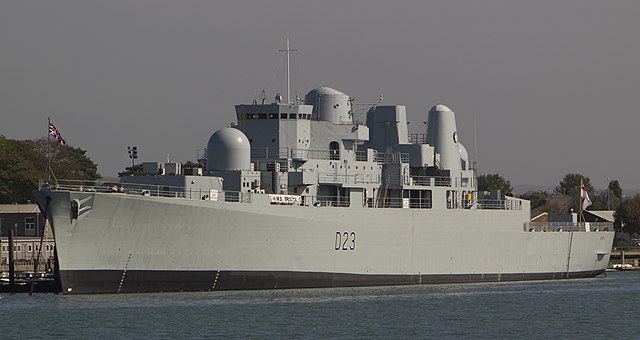
Bristol in 2012
After the Falklands she remained in commission (notably due to the losses of the war) making several overseas deployments and another refit in 1984 during which she suffered another boiler explosion leading to again, extensive damage. Major repair work undertaken to replace the Type 965 with Type 1022, Ikara system removed with the intention of replacing it with two triple STWS-1 launchers (324 mm anti-submarine torpedoes) but this never materialized.
In 1987, she became part of Dartmouth training squadron, having extra accommodation and classrooms fitted, installed in the former Ikara/Limbo spaces. This went on until the end of the cold war, and she was umtmately decommissioned on 14 June 1991, reconfigured for this new role in 1993, replacing HMS Kent as static training ship “HMS Excellent”, berthed at a shore facility in Portsmouth.
This eliminated the troublesome steam plant. This new static role went on until 28 October 2020, when she was decommissioned a last time, since then as we speak (Nov. 2023) awaiting disposal. There is no thoughts of preserviing her as a museum ship so far though.
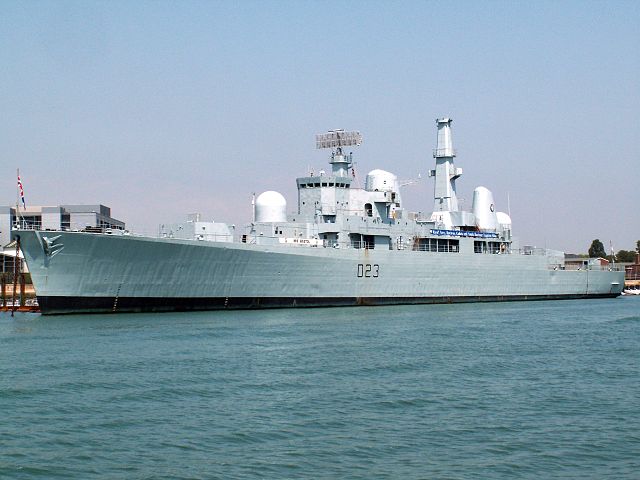
HMS Bristol disarmed at Portsmouth as of today
Read More/Src
Books
PRO ADM 205/220. Controller of the Navy, ‘Memo Type 82 Legend, Plan and Drawing’. Admin Board. RNC & RN Staff,Lewin and Ashmore et al, 7/7/65
Dr Andrea Ellner. ‘Innovation & Surface Ships. The Type 42 and the Future Fleet Working Party’ in Mariner’s Mirror, No 3, Vol 95, (2005). UK, pp454-469
“Unit cost, i.e. excluding cost of certain items (e.g. aircraft, First Outfits)”. Defence Estimates, 1973–74 (Report). Ministry of Defence.
“Table V: List and particulars of new ships which have been accepted or are expected to be accepted into HM service during the Financial Year ended 31st March 1973”. Defence Estimates, 1973–74 (Report). Ministry of Defence. p. XII-96.
Grove, Eric. J (1989). Vanguard to Trident : British Naval Policy since World War II. The Bodley Head.
Marriott, Leo (1989). Royal Navy Destroyers Since 1945. Ian Allan Publishing.
Moore, John, ed. (1981). Jane’s Fighting Ships 1980–81. Jane’s Publishing Company.
Conway’s all the world’s fighting ships 1947-1995
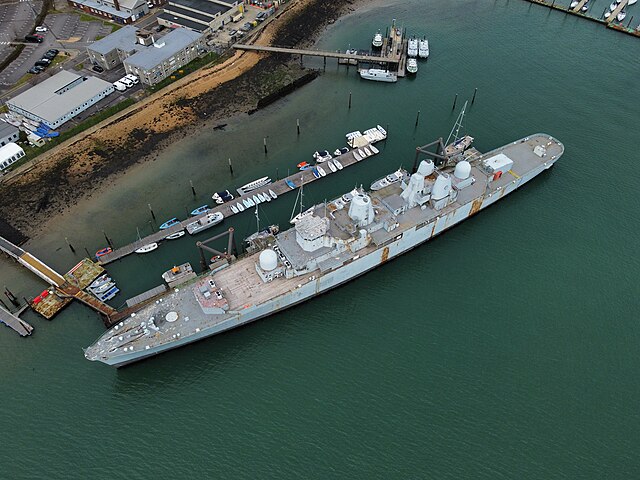
HMS Excellent, decommissioned and in gradual scrapping as of 2023.
Links
hmsbristol.plus.com/info.htm
archive.org automated sytem aboard
on seaforces.org/
on ukdefencejournal.org.uk/
janes fightingships pages on bristol
on secretprojects.co.uk
on historyofwar.org/
en.wikipedia.org/wiki/HMS_Bristol_(D23)
cc photos
Videos
Model Kits
MT miniature made a 1:700 kit – full review here on steelnavy.net.

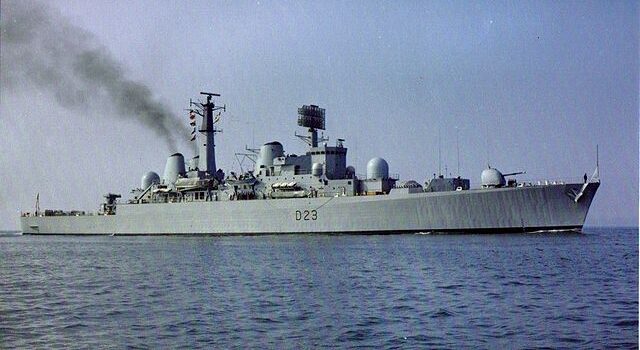

 Latest Facebook Entry -
Latest Facebook Entry -  X(Tweeter) Naval Encyclopedia's deck archive
X(Tweeter) Naval Encyclopedia's deck archive Instagram (@navalencyc)
Instagram (@navalencyc)





 French Navy
French Navy Royal Navy
Royal Navy Russian Navy
Russian Navy Armada Espanola
Armada Espanola Austrian Navy
Austrian Navy K.u.K. Kriegsmarine
K.u.K. Kriegsmarine Dansk Marine
Dansk Marine Nautiko Hellenon
Nautiko Hellenon Koninklije Marine 1870
Koninklije Marine 1870 Marinha do Brasil
Marinha do Brasil Osmanlı Donanması
Osmanlı Donanması Marina Do Peru
Marina Do Peru Marinha do Portugal
Marinha do Portugal Regia Marina 1870
Regia Marina 1870 Nihhon Kaigun 1870
Nihhon Kaigun 1870 Preußische Marine 1870
Preußische Marine 1870 Russkiy Flot 1870
Russkiy Flot 1870 Svenska marinen
Svenska marinen Søværnet
Søværnet Union Navy
Union Navy Confederate Navy
Confederate Navy Armada de Argentina
Armada de Argentina Imperial Chinese Navy
Imperial Chinese Navy Marinha do Portugal
Marinha do Portugal Mexico
Mexico Kaiserliche Marine
Kaiserliche Marine 1898 US Navy
1898 US Navy Sovietskiy Flot
Sovietskiy Flot Royal Canadian Navy
Royal Canadian Navy Royal Australian Navy
Royal Australian Navy RNZN Fleet
RNZN Fleet Chinese Navy 1937
Chinese Navy 1937 Kriegsmarine
Kriegsmarine Chilean Navy
Chilean Navy Danish Navy
Danish Navy Finnish Navy
Finnish Navy Hellenic Navy
Hellenic Navy Polish Navy
Polish Navy Romanian Navy
Romanian Navy Turkish Navy
Turkish Navy Royal Yugoslav Navy
Royal Yugoslav Navy Royal Thai Navy
Royal Thai Navy Minor Navies
Minor Navies Albania
Albania Austria
Austria Belgium
Belgium Columbia
Columbia Costa Rica
Costa Rica Cuba
Cuba Czechoslovakia
Czechoslovakia Dominican Republic
Dominican Republic Haiti
Haiti Hungary
Hungary Honduras
Honduras Estonia
Estonia Iceland
Iceland Eire
Eire Equador
Equador Iran
Iran Iraq
Iraq Latvia
Latvia Liberia
Liberia Lithuania
Lithuania Mandchukuo
Mandchukuo Morocco
Morocco Nicaragua
Nicaragua Persia
Persia San Salvador
San Salvador Sarawak
Sarawak Uruguay
Uruguay Venezuela
Venezuela Zanzibar
Zanzibar Warsaw Pact Navies
Warsaw Pact Navies Bulgaria
Bulgaria Hungary
Hungary

 Bundesmarine
Bundesmarine Dutch Navy
Dutch Navy Hellenic Navy
Hellenic Navy Marina Militare
Marina Militare Yugoslav Navy
Yugoslav Navy Chinese Navy
Chinese Navy Indian Navy
Indian Navy Indonesian Navy
Indonesian Navy JMSDF
JMSDF North Korean Navy
North Korean Navy Pakistani Navy
Pakistani Navy Philippines Navy
Philippines Navy ROKN
ROKN Rep. of Singapore Navy
Rep. of Singapore Navy Taiwanese Navy
Taiwanese Navy IDF Navy
IDF Navy Saudi Navy
Saudi Navy Royal New Zealand Navy
Royal New Zealand Navy Egyptian Navy
Egyptian Navy South African Navy
South African Navy






























 Ukrainian Navy
Ukrainian Navy dbodesign
dbodesign